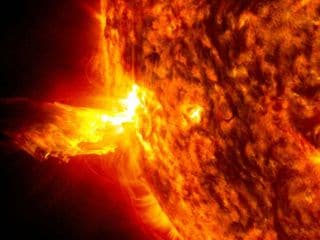- Home
- Science
- Science News
- NASA Missions Uncover a Diverse Galaxy of Super Earths, Raising New Questions About Planetary Evolution
NASA Missions Uncover a Diverse Galaxy of Super-Earths, Raising New Questions About Planetary Evolution
Super-Earths—planets larger than Earth yet smaller than Neptune—span rocky, watery, and extreme worlds.

Photo Credit: NASA
Super-Earths: Unique exoplanets expanding our understanding of habitability beyond Earth-like worlds
Astronomers have found a menagerie of "super-Earth" exoplanets — worlds a few times Earth's mass — in our galaxy. These new planets range from rocky to gas-rich. They are larger than Earth but smaller than Neptune, and can be rocky, gaseous, or both. Their true nature remains “shrouded in uncertainty,” because none exist near home, yet NASA notes they are common.
A Spectrum of Super-Earths
As suggested by recent NASA-supported studies, Super-Earths exhibit remarkable diversity in composition and environment. Some may be water worlds, dominated by deep global oceans. Others sit tantalizingly within the habitable zones of their stars—regions where liquid water could exist—with candidates including TOI-715 b, Kepler-62 e, and Kepler-452 b.
For example, Kepler-452 b, often dubbed “Earth's Cousin,” orbits a Sun-like star at nearly 1 AU and may be rocky, although it could be too hot for life. Yet not all super-Earths are serene—some, like Kepler-725 c, follow highly elliptical paths, spending only part of their orbits in temperate zones, while others experience violent day–night temperature swings. There are even extreme examples: LHS 3844 b is believed to be tidally locked, with one side perpetually hot and the other frozen, and likely lacks an atmosphere altogether.
Scientific Significance and Challenges
Super-Earths hold the key to unraveling the complexities of planetary evolution—yet they also complicate the narrative. They are far more common than Earth-sized planets, and challenge the traditional categories of terrestrial versus giant planets.
Their very abundance raises questions: Why does our solar system lack such planets? Was one present early on and later lost or destroyed? Moreover, defining “super-Earth” remains debated; its use refers strictly to mass (or size), not habitability or similarity to Earth. As upcoming space missions like PLATO and JWST begin probing exoplanet atmospheres, researchers hope to clarify which super-Earths are rocky, watery, gaseous—or perhaps harbor signs of life.
Get your daily dose of tech news, reviews, and insights, in under 80 characters on Gadgets 360 Turbo. Connect with fellow tech lovers on our Forum. Follow us on X, Facebook, WhatsApp, Threads and Google News for instant updates. Catch all the action on our YouTube channel.
Related Stories
- Samsung Galaxy Unpacked 2025
- ChatGPT
- Redmi Note 14 Pro+
- iPhone 16
- Apple Vision Pro
- Oneplus 12
- OnePlus Nord CE 3 Lite 5G
- iPhone 13
- Xiaomi 14 Pro
- Oppo Find N3
- Tecno Spark Go (2023)
- Realme V30
- Best Phones Under 25000
- Samsung Galaxy S24 Series
- Cryptocurrency
- iQoo 12
- Samsung Galaxy S24 Ultra
- Giottus
- Samsung Galaxy Z Flip 5
- Apple 'Scary Fast'
- Housefull 5
- GoPro Hero 12 Black Review
- Invincible Season 2
- JioGlass
- HD Ready TV
- Laptop Under 50000
- Smartwatch Under 10000
- Latest Mobile Phones
- Compare Phones
- OnePlus 15R
- Realme Narzo 90x 5G
- Realme Narzo 90 5G
- Vivo S50 Pro Mini
- Vivo S50
- OPPO Reno 15c
- Redmi Note 15 5G
- Redmi Note 15 Pro 5G
- Asus ProArt P16
- MacBook Pro 14-inch (M5, 2025)
- Infinix Xpad Edge
- OnePlus Pad Go 2
- OnePlus Watch Lite
- Just Corseca Skywatch Pro
- Acerpure Nitro Z Series 100-inch QLED TV
- Samsung 43 Inch LED Ultra HD (4K) Smart TV (UA43UE81AFULXL)
- Asus ROG Ally
- Nintendo Switch Lite
- Haier 1.6 Ton 5 Star Inverter Split AC (HSU19G-MZAID5BN-INV)
- Haier 1.6 Ton 5 Star Inverter Split AC (HSU19G-MZAIM5BN-INV)

















